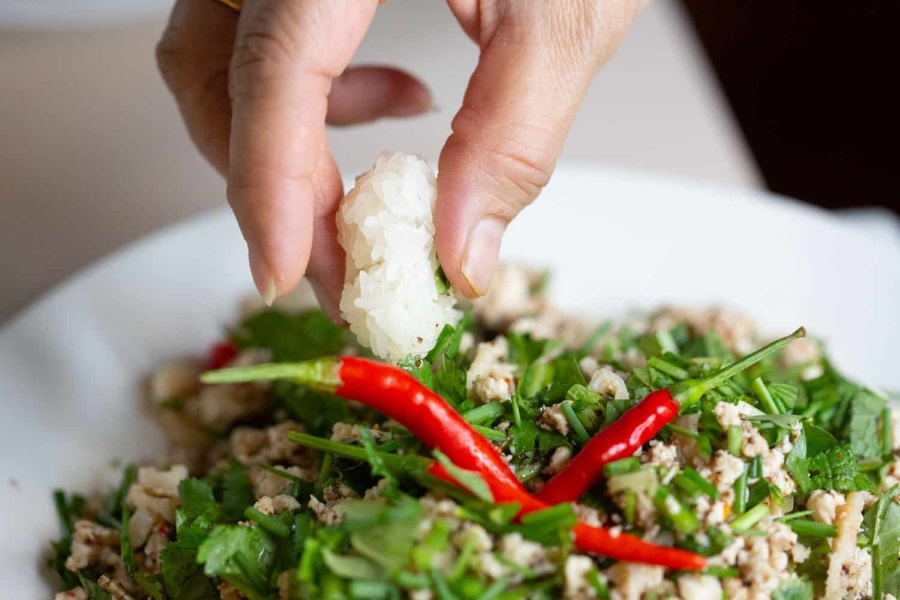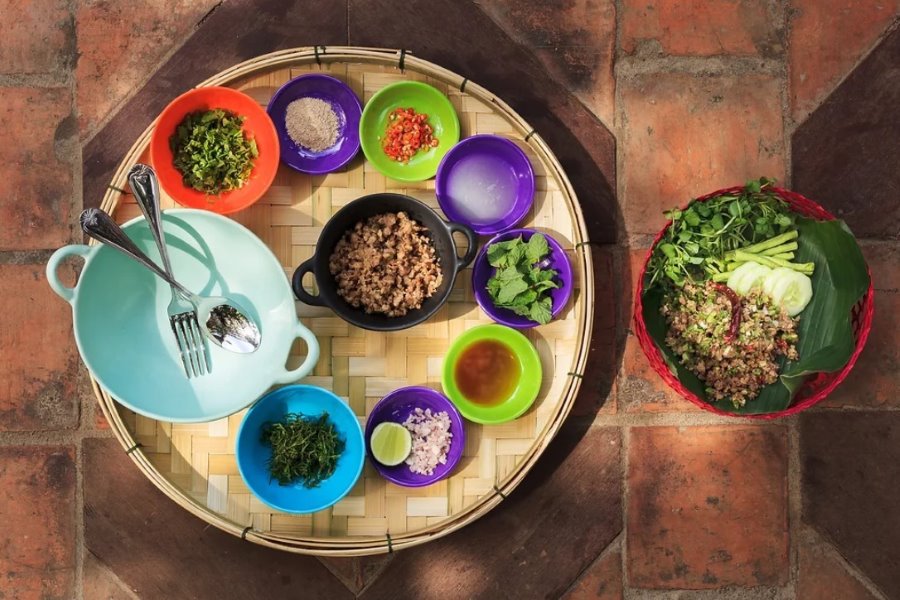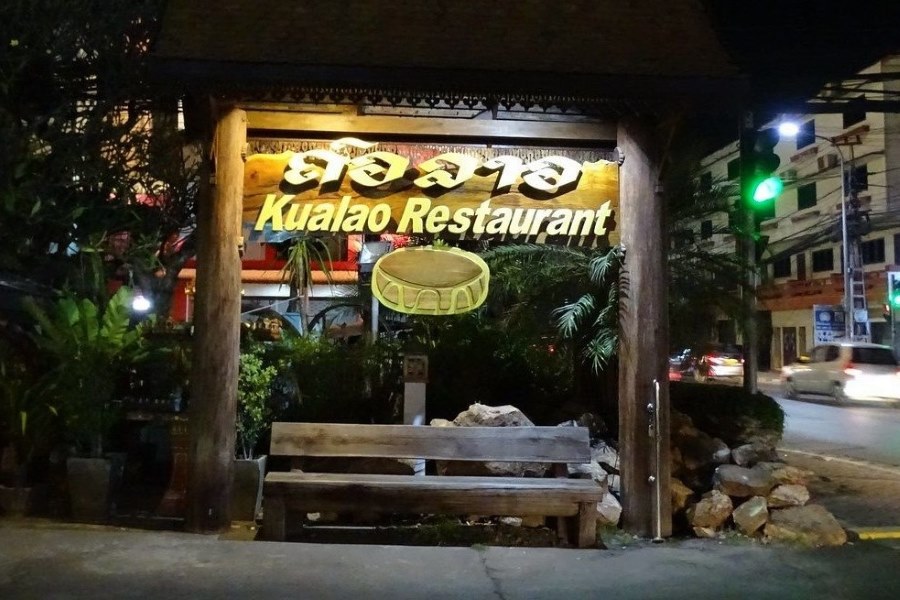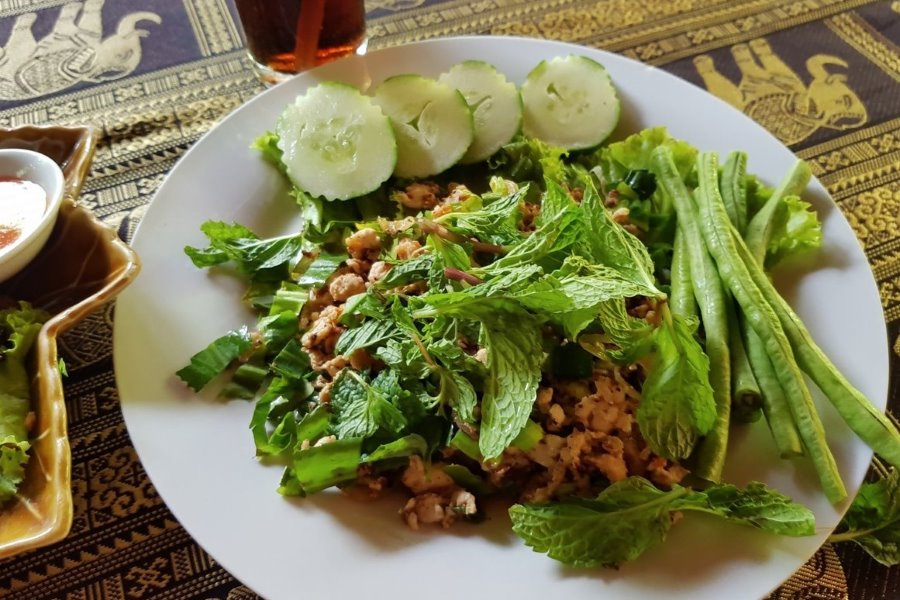
As a main part of Laotian traditional cuisine, most visitors who know Laap or have been to Laos would know this cultural food. In the belief of bringing luck, happiness, and hospitality, Laap is particularly served on many important occasions. Let's take a closer look at this unique national dish.
Laap is essentially a salad with a meat base, flavored with lime, garlic, fish sauce, mint leaves, spring onion, and ground toasted rice, which adds a subtle nutty flavor.
Laap is also spelled as Lahp, Larb, Lahp, Lahb, and several other phonetic variations. There are 2 common terms to call the dish: the term "Laap" refers to the overall preparation method, while "Larb" refers to the chopping or mincing of the meat.
The main protein might be chicken, pork, beef, buffalo, duck, or fish, and some restaurants have vegetarian versions made with mushrooms or tofu. Dried chilies, banana flowers, and raw vegetables may be placed as accompaniments on the side, and regardless of the meat (or non-meat) of choice, you’d be hard-pressed to come across a bland plate of Laap.

Flavourful and filling, yet also refreshing, Laap is a perfect dish to have on a typical hot Lao day (Source: Mattarello(a)way)
Many might assume that Laap is a popular food in Thailand, but it originated in Laos where it is largely considered the National dish. In the past, the dish migrated and became popular in Thailand. Today, the dish is regional to both Laos and Isan, the Northeastern region of Thailand.

Known mostly as a Thai dish in the US, Laap has a complex story reflective of unique migration patterns and state sponsorship (Souce: Kitchen Gatherings)
There are cooked and raw versions of Laap and some versions include various animal organs such as tripe, liver, intestine, etc. But for the sake of your health, we’d suggest not eating the raw versions, except at more upscale restaurants, where kitchen hygiene and ingredient quality are kept to a high standard.
Read more:The Significance of Sticky Rice in Lao Culture and Cuisine
Although, in general, Laap lacks bright colors unlike many other Lao traditional dishes, and the ingredients are quite simple. But it is a dish that always contains wishes for peace and luck that Lao people want to give to tourists when visiting their country.
Traditionally, Lao people considered Laab to be an auspicious and lucky dish because meat was not readily available. Most Lao people normally eat Laap on special occasions, such as weddings, New Year celebrations, and festivals.
During the New Year, many Lao families believe that eating Laap on day one of the three-day celebration will bring good fortune for the rest of the year.

Laap is so prominent in Lao culture that it is mentioned in Lao blessing rituals (Source: Morgane Recipes)
As millions of Lao people celebrate Lao New Year both people in the country and living abroad, there will be at least one type of Laap dish on the Pha Khao (a bamboo tray) or table to celebrate this most festive of occasions.
Another noticeable fact is that the dish is always prepared with gratitude and respect by local people. Because many believe that if you do not prepare the dish carefully, it can bring you bad luck.
The Lao have a saying that you aren’t truly full unless you’ve had sticky rice, and a plate of Laap would not be complete without it. If you want to eat Laap like the Lao do, order it plus any other dishes and sticky rice family style and try eating it with your hands.
First, grab enough sticky rice to fit inside a closed hand and use it to scoop off a bit of Laap. Make sure you firmly shape the sticky rice as it’s considered impolite to leave grains of sticky rice in the communal food plates, although there is no taboo against mashing the rice in the palm of your hand for a bit before dipping it into the food.

Using your hand is the proper way to eat Laap like a Lao (Souce: Cooking with Lane)
Wash it all down with a cold Beer Lao and you may struggle to find a more perfect dish to complete each day for the remainder of your trip.
Although there are many recipes and methods to prepare and make the dish, we do recommend you stay close to tradition in order to ensure an authentic flavor as it is meant to be. Here is the most common recipe to make Laap.

There are many recipes for Laap nowadays (Source: Manda de Laos)
Ingredients
Step 1: Cook sticky rice
You can cook sticky rice with a rice cooker. But if you don’t have it, you can make it with a steamer by simply following this method.
First, bring your water to a boil and transfer your soaked (about 6-8 hours), rinsed rice into your steamer. Then, cover the steamer basket, place over the boiling water, and steam on high heat for 35-45 minutes until the rice is translucent and bouncy.
Step 2: Prepare the ingredients
Step 3: Mix and present the dish
Laap is available at just about any restaurant and even street food stalls in Laos. The quality and price do vary, but even a budget dish of Laap is still a satisfying choice. Here are some recommended restaurants for you to have a perfect plate of Laap.
1. Kualao Restaurant

Kualao Restaurant is a place for you to explore Lao traditional cuisine (Source: Wanderlog)
Kualao Restaurant is a well-known, internationally recognized, and up-scale Lao food restaurant located in Vientiane. It features a classic Lao atmosphere with a harmonious mix of East and West. Besides its Laap dishes, the restaurant is famed for many other delicious traditional dishes, including papaya salad, handmade Lao sausage, deep-fried Mekong fish, spring rolls, etc.
2. Phakhao Lao Restaurant

Duck Laap - a signature dish of Pha Khao Lao Restaurant (Source: Wanderlog)
This Laotian restaurant is known for its duck Laap, which is said to be the best in town. They also have a large variety of Lao and Thai dishes, ranging from 40,000 Kips for sharing. The restaurant is located in an alley near Wat Ong Teu and the river and has a garden terrace where you can sit under lanterns and enjoy authentic Lao food.
3. Pa Kham Tanh Laap Restaurant
.jpg)
Pa Kham Tanh Laap Restaurant Laap dish (Source: Migrationology)
Pa Kham Tanh Laap Restaurant is a local favorite in Vientiane, Laos, known for serving an outstanding and authentic version of the popular Laap dish. The dish here is made with meat, mint leaves, spring onions, coriander, and lemon. The main seasoning used at Pa Kham Tanh is Padek (a type of fermented fish) with ground-roasted rice.
4. Tamarind Restaurant and Cooking School

Tamarind Restaurant and Cooking School offers you a wide range of vegetable base dishes (Source: Tamarind Restaurant and Cooking School)
If you are a non-meat person, it is hard for you to enjoy a Laap dish because the veggie-vegan versions of the dish are the minority in Laos. But, if you are traveling to Luang Prabang, you can visit Tamarind Restaurant and Cooking School near the Nam Khan River, which offers plant-based dishes on its menu. This includes a vegetarian tofu Laap.
Among the various and eye-catching Lao dishes, Laap truly stands out as the most versatile dish and has a deep meaning in Lao cultural basis and everyday life. If you wish to come to Laos and indulge your taste buds with this “lucky” National food, make sure to reach out to our support team so that we can help you create memorable moments.
Read more: Must-try dishes when coming to Laos